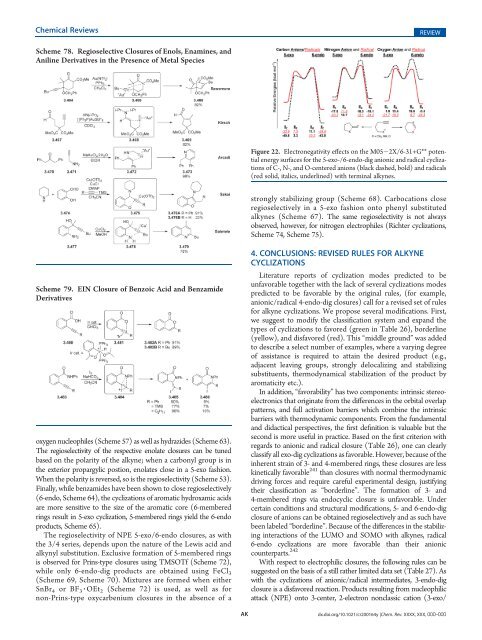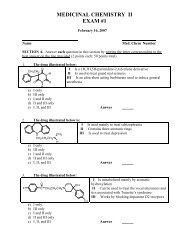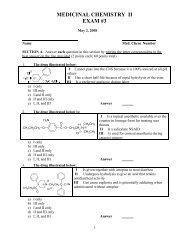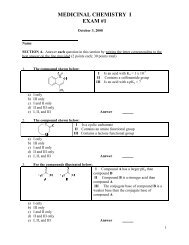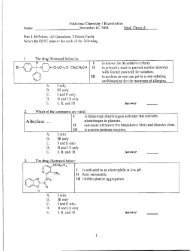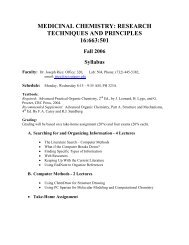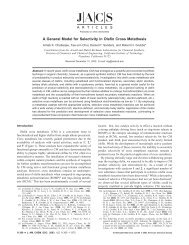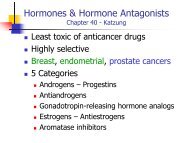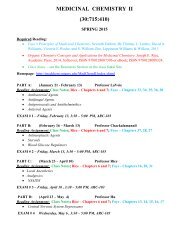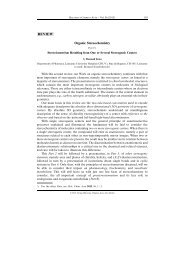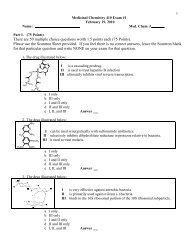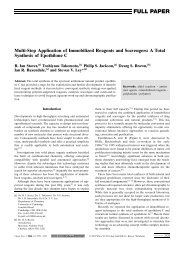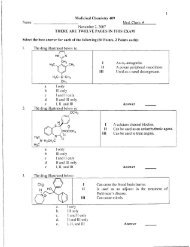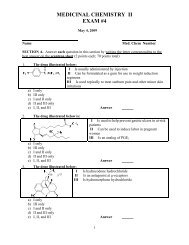Baldwin's Rules - Department of Medicinal Chemistry
Baldwin's Rules - Department of Medicinal Chemistry
Baldwin's Rules - Department of Medicinal Chemistry
You also want an ePaper? Increase the reach of your titles
YUMPU automatically turns print PDFs into web optimized ePapers that Google loves.
Chemical Reviews REVIEW<br />
Scheme 78. Regioselective Closures <strong>of</strong> Enols, Enamines, and<br />
Aniline Derivatives in the Presence <strong>of</strong> Metal Species<br />
Scheme 79. EIN Closure <strong>of</strong> Benzoic Acid and Benzamide<br />
Derivatives<br />
oxygen nucleophiles (Scheme 57) aswellashydrazides(Scheme63).<br />
The regioselectivity <strong>of</strong> the respective enolate closures can be tuned<br />
based on the polarity <strong>of</strong> the alkyne; when a carbonyl group is in<br />
the exterior propargylic postion, enolates close in a 5-exo fashion.<br />
When the polarity is reversed, so is the regioselectivity (Scheme 53).<br />
Finally, while benzamides have been shown to close regioselectively<br />
(6-endo, Scheme 64), the cyclizations <strong>of</strong> aromatic hydroxamic acids<br />
are more sensitive to the size <strong>of</strong> the aromatic core (6-membered<br />
rings result in 5-exo cyclization, 5-membered rings yield the 6-endo<br />
products, Scheme 65).<br />
The regioselectivity <strong>of</strong> NPE 5-exo/6-endo closures, as with<br />
the 3/4 series, depends upon the nature <strong>of</strong> the Lewis acid and<br />
alkynyl substitution. Exclusive formation <strong>of</strong> 5-membered rings<br />
is observed for Prins-type closures using TMSOTf (Scheme 72),<br />
while only 6-endo-dig products are obtained using FeCl 3<br />
(Scheme 69, Scheme 70). Mixtures are formed when either<br />
SnBr4 or BF3 3 OEt2 (Scheme 72) is used, as well as for<br />
non-Prins-type oxycarbenium closures in the absence <strong>of</strong> a<br />
Figure 22. Electronegativity effects on the M05 2X/6-31+G** potential<br />
energy surfaces for the 5-exo-/6-endo-dig anionic and radical cyclizations<br />
<strong>of</strong> C-, N-, and O-centered anions (black dashed, bold) and radicals<br />
(red solid, italics, underlined) with terminal alkynes.<br />
strongly stabilizing group (Scheme 68). Carbocations close<br />
regioselectively in a 5-exo fashion onto phenyl substituted<br />
alkynes (Scheme 67). The same regioselectivity is not always<br />
observed, however, for nitrogen electrophiles (Richter cyclizations,<br />
Scheme 74, Scheme 75).<br />
4. CONCLUSIONS: REVISED RULES FOR ALKYNE<br />
CYCLIZATIONS<br />
Literature reports <strong>of</strong> cyclization modes predicted to be<br />
unfavorable together with the lack <strong>of</strong> several cyclizations modes<br />
predicted to be favorable by the original rules, (for example,<br />
anionic/radical 4-endo-dig closures) call for a revised set <strong>of</strong> rules<br />
for alkyne cyclizations. We propose several modifications. First,<br />
we suggest to modify the classification system and expand the<br />
types <strong>of</strong> cyclizations to favored (green in Table 26), borderline<br />
(yellow), and disfavored (red). This “middle ground” was added<br />
to describe a select number <strong>of</strong> examples, where a varying degree<br />
<strong>of</strong> assistance is required to attain the desired product (e.g.,<br />
adjacent leaving groups, strongly delocalizing and stabilizing<br />
substituents, thermodynamical stabilization <strong>of</strong> the product by<br />
aromaticity etc.).<br />
In addition, “favorability” has two components: intrinsic stereoelectronics<br />
that originate from the differences in the orbital overlap<br />
patterns, and full activation barriers which combine the intrinsic<br />
barriers with thermodynamic components. From the fundamental<br />
and didactical perspectives, the first definition is valuable but the<br />
second is more useful in practice. Based on the first criterion with<br />
regards to anionic and radical closure (Table 26), one can clearly<br />
classify all exo-dig cyclizations as favorable. However, because <strong>of</strong> the<br />
inherent strain <strong>of</strong> 3- and 4-membered rings, these closures are less<br />
kinetically favorable 241 than closures with normal thermodynamic<br />
driving forces and require careful experimental design, justifying<br />
their classification as “borderline”. The formation <strong>of</strong> 3- and<br />
4-membered rings via endocyclic closure is unfavorable. Under<br />
certain conditions and structural modifications, 5- and 6-endo-dig<br />
closure <strong>of</strong> anions can be obtained regioselectively and as such have<br />
been labeled “borderline”. Because <strong>of</strong> the differences in the stabilizing<br />
interactions <strong>of</strong> the LUMO and SOMO with alkynes, radical<br />
6-endo cyclizations are more favorable than their anionic<br />
counterparts. 242<br />
With respect to electrophilic closures, the following rules can be<br />
suggested on the basis <strong>of</strong> a still rather limited data set (Table 27). As<br />
with the cyclizations <strong>of</strong> anionic/radical intermediates, 3-endo-dig<br />
closure is a disfavored reaction. Products resulting from nucleophilic<br />
attack (NPE) onto 3-center, 2-electron nonclassic cation (3-exo/<br />
AK dx.doi.org/10.1021/cr200164y |Chem. Rev. XXXX, XXX, 000–000


